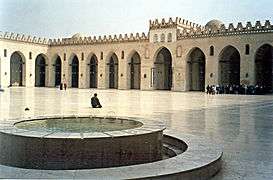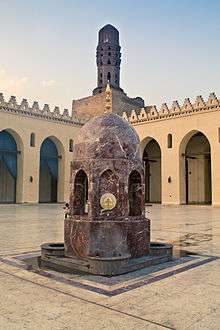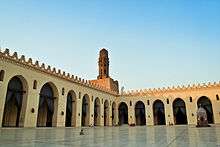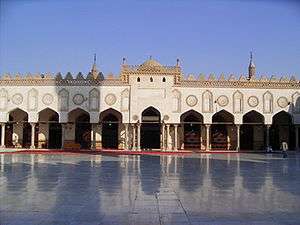Al-Hakim Mosque
| Al-Hakim Mosque | |
|---|---|
 Interior courtyard of the mosque | |
| Basic information | |
| Location | Cairo, Egypt |
| Affiliation | Islam |
| Year consecrated | 928 |
| Ecclesiastical or organizational status | Mosque |
| Leadership | Al-Hakim bi-Amr Allah |
| Architectural description | |
| Architectural type | Mosque |
| Architectural style | Fatimid |
| Completed | 992 |
| Specifications | |
| Dome(s) | 1 |
| Minaret(s) | 2 |
Al-Jam`e Al-Anwar (Arabic: الجامع الانور, Anwar Mosque, literally:The Enlightened Mosque) also Al-Hakim Mosque is a major Islamic religious site in Cairo, Egypt. It is named after Imam Al-Hakim bi-Amr Allah (985–1021), the sixth Fatimid caliph,16 th Fatimid/Ismaili Imam and the first to be born in Egypt.
The mosque was originally built as an enclosure by the Fatimid vizier Gawhar Al-Siqilli (c. 928–992), but was incorporated into the extended fortifications built by Badr al-Jamali. It consists of an irregular rectangle with four arcades surrounding the courtyard. An unusual feature is the monumental entrance with its projecting stone porch. It is located in "Islamic Cairo", on the east side of Muizz Street, just south of Bab Al-Futuh (the northern gate).



The minarets
The most spectacular feature of the mosque are the minarets on either side of the facade, reminiscent of the propylon to a pharaonic temple.
Originally the two minarets stood independent of the brick walls at the corners. These are the earliest surviving minarets in the city and they have been restored at various times during their history. The massive salients were added in 1010 to strengthen their structure, and the northern minaret was incorporated into the city wall. Inside, these strange structures are hollow, for they have been built around the original minarets, which are connected with brackets and can still be seen from the minaret above.
Post-Fatimid era
At various times, the mosque was used as a prison for captured Franks(i.e. Latin crusaders) during the Crusades, as a stable by Saladin, as a fortress by Napoleon, and as a local school. As a result of this the mosque had fallen out of use.
In 1980 ACE/1401 AH, the mosque was extensively refurbished in white marble and gold trim by Syedna Mohammed Burhanuddin the head of the Dawoodi Bohra, an international Ismaili sect based in India. Remnants of the original decorations, including stucco carvings, timber tie-beams, and Quranic inscriptions were restored as part of the renovations.
Today
Today the mosque is a place of worship. Its unique minarets attracts local and foreign tourists. Al-Hakim Mosque is now a place for Egyptians to feed pigeons and enjoy the calm and peacefulness of the Mosque.
References
Gallery
-

-

Courtyard and minaret
-

Front of the mosque
-

The qibla, renovated by Dawoodi Bohra
-

Interior near the Mehrab
-

Entrance gate
-

fountain
-

See also
Coordinates: 30°03′16″N 31°15′49″E / 30.054571°N 31.263742°E

